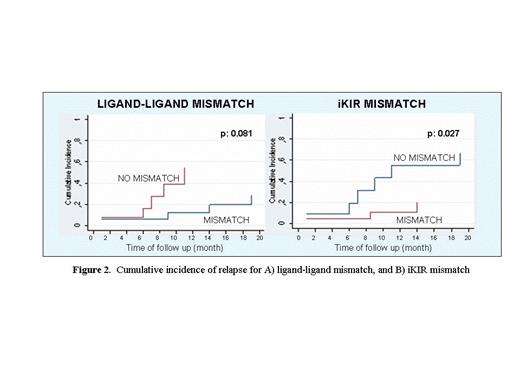Abstract
Alloreactivity triggered by interaction of Killer immunoglobulin-like receptors (KIRs) on donor Natural killer (NK) cells and their ligands on recipients plays a role in the graft-versus-tumour effect. Different predictive models have been postulated for measuring alloreactivity: ligand incompatibility model, receptor-ligand model, missing ligand model and KIR gene-gene model. Our aim in this study is to evaluate the importance of differences in KIR and HLA genotype between donor and recipient (missing ligand model and KIR gene-gene model) in the setting of non T cell depleted haploidentical haematopoietic stem cell transplantation (HSCT) with high-dose, post-infusion cyclophosphamide (Cy)
33 consecutive patients with haematological malignancies who received haploidentical HSCT with high-dose Cy post-transplantation between 2007 and 2013, and their donors were included for analysis (Table 1). HLA typing was used to identify KIR ligands HLA-B and HLA-C. KIR genotype was analyzed by PCR (KIR Typing, Miltenyi Biotec) on genomic DNA (Maxwell 16 Blood DNA Kit, Promega) from peripheral blood samples, and revealed with ethidium bromide after agarose gel electrophoresis.
Demographic data and KIR genotype characteristics of donors and recipients
| Number of patients . | 33 . |
|---|---|
| Median age (range) | 40 (19-65) |
| Sex n (%) | Men 24 (73) |
| Women 9 (27) | |
| Donor’s relationship n (%) | Father 2 (6) |
| Mother 9 (27) | |
| Sibling 14 (43) | |
| Son/Daughter 8 (24) | |
| Diagnosis n (%) | AML 10 (30) |
| ALL 2 (6) | |
| MPSc 2 (6) | |
| HL 12 (36) | |
| NHL 2 (6) | |
| MM 2 (6) | |
| MDS 3 (9) | |
| Response pre-trasplant n (%) | CR 18 (54) |
| PR 15 (45) | |
| Donor Haplotype n (%) | A-A 5 (15) |
| B-x 28 (84) | |
| CenB-B 8 (24) | |
| Tel B-B 7 (21) | |
| Patient haplotype n (%) | A-A 6 (9) |
| B-x 27 (81) | |
| Conditioning intensity n (%) | MINI 22 (66) |
| MAXI 11 (34) |
| Number of patients . | 33 . |
|---|---|
| Median age (range) | 40 (19-65) |
| Sex n (%) | Men 24 (73) |
| Women 9 (27) | |
| Donor’s relationship n (%) | Father 2 (6) |
| Mother 9 (27) | |
| Sibling 14 (43) | |
| Son/Daughter 8 (24) | |
| Diagnosis n (%) | AML 10 (30) |
| ALL 2 (6) | |
| MPSc 2 (6) | |
| HL 12 (36) | |
| NHL 2 (6) | |
| MM 2 (6) | |
| MDS 3 (9) | |
| Response pre-trasplant n (%) | CR 18 (54) |
| PR 15 (45) | |
| Donor Haplotype n (%) | A-A 5 (15) |
| B-x 28 (84) | |
| CenB-B 8 (24) | |
| Tel B-B 7 (21) | |
| Patient haplotype n (%) | A-A 6 (9) |
| B-x 27 (81) | |
| Conditioning intensity n (%) | MINI 22 (66) |
| MAXI 11 (34) |
AML: acute myeloid leukemia., ALL: acute limphoblastic leukemia, MM: multiple myeloma, HL: Hodking Lymphoma, MDS: mielodisplastic syndrome, MPS: mieloproliferative syndrome, NHL: no Hodking lymphoma, PR: partial response, CR: complete response. n: number
Demographic data and KIR genotype characteristics of donors and recipients are listed in Table 1. We found that KIR ligands mismatch between donor and recipient is related with improve of OS (52% vs. 82%; p=0,041) and DFS (63% vs. 22%; p=0,037) a year after transplant (Figure 1). Mismatch of inhibitors KIR receptors (iKIR) gene content between donors and recipients is also related with an improvement of OS (94% vs. 75%; p=0,049) and DFS (13% vs. 61%; p= 0,028) compared with no mismatch pairs. In the multivariable analysis, both KIR ligands mismatches (HR=4,38 CI:0.9-21; p=0,061) as well as iKIR mismatches (HR=4,15 CI:1-16; p=0,047), show a tendency to be independent variables for the reduction of disease relapse rate. Cumulative incidence of relapse for both variables studied is shown in Figure 2. Conspicuously, a sub-analysis in Hodgkin Lymphoma patients group shows and improve in DFS a year after transplant in patients with KIR ligands mismatches ( 100% vs. 48% p: 0,006) and iKIR mismatches (100% vs. % 33% p: 0,049), despite the small number of patients. Contrary to data published by other groups, patients receiving donor’s progenitors with Bx haplotype with centromeric genes (Cen-BB) did not show a benefit in survival (SG 85% vs. 90%, p= 0,05 and DFS 66% vs. 10%, p=0,047) a year after transplant
Global survival (A) and Disease free survival (B) in patients who receive transplant from donors with (GREEN) or without (BLUE) differences in iKIR.
Global survival (C) and Disease free survival (D) in patients who receive transplant from donors with (BLUE) or without (GREEN) differences between KIR ligands
Global survival (A) and Disease free survival (B) in patients who receive transplant from donors with (GREEN) or without (BLUE) differences in iKIR.
Global survival (C) and Disease free survival (D) in patients who receive transplant from donors with (BLUE) or without (GREEN) differences between KIR ligands
Our data suggest that in the setting of non T cell depleted haploidentical HSCT with high dose Cy post-infusion, KIR ligands and iKIR mismatch are related with an improve in survival, specially in the sub-group of patients with Hodgkin disease
No relevant conflicts of interest to declare.
Author notes
Asterisk with author names denotes non-ASH members.



This feature is available to Subscribers Only
Sign In or Create an Account Close Modal